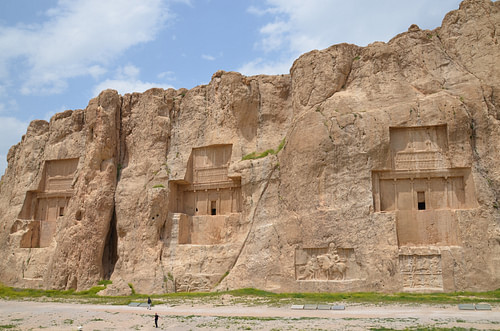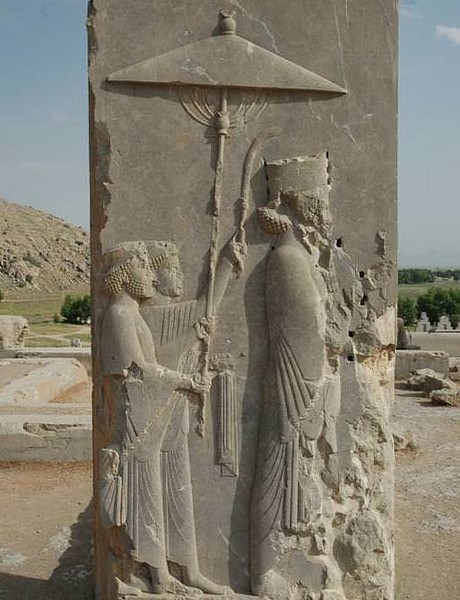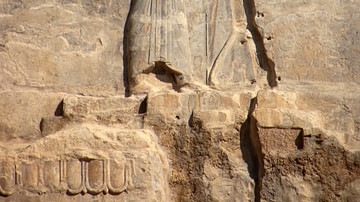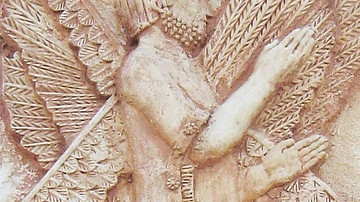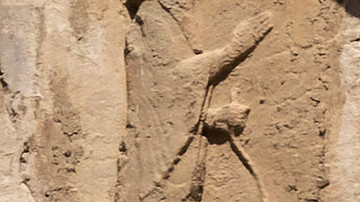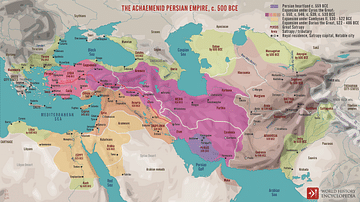The Achaemenid Empire (c. 550-330 BCE) was the first great Persian political entity in Western and Central Asia which stretched, at its peak, from Asia Minor to the Indus Valley and Mesopotamia through Egypt. It was founded by Cyrus II (the Great, r. c. 550-530 BCE) whose vision of a vast, all-inclusive Persian Empire was, more or less, maintained by his successors.
The Persians arrived in the region of modern-day Iran as part of a migratory group of Aryans (meaning “noble” or “free” and referencing a class of people, not a race). The Aryans – made up of many tribes such as the Alans, Bactrians, Medes, Parthians, and Persians, as well as others – settled in the area which became known as Ariana (Iran) – “the land of the Aryans”. The tribe which eventually became known as the Persians settled at Persis (modern-day Fars) which gave them their name.
Cyrus II defeated the Medes, Lydians, Elamites, and Babylonians to found his empire which, once it was consolidated, was further expanded upon by his successors. The empire reached its height under Darius I (the Great, r. 522-486 BCE) who launched the first Persian invasion of Greece which was defeated at the Battle of Marathon in 490 BCE. This was a setback for the Persians but did nothing to diminish Darius I's reign.
His son and successor, Xerxes I (r. 486-465 BCE), raised a large army and led it in the second Persian invasion of Greece which was also defeated by 479 BCE. This defeat did affect the empire because Xerxes I was simply not the kind of king his father had been, depleted the treasury for his campaign, and spent the rest of his reign despondent over his failure. His interest in affairs of state evaporated afterwards and he concerned himself more with his harem and building projects. Many scholars date his reign as the beginning of the decline of the empire.
Persian power was renewed by Artaxerxes I (r. 465-424 BCE) who helped to destabilize Greece by funding Sparta in the First Peloponnesian War (460-446 BCE), a policy continued under Darius II (r. 424-404 BCE) in the Second Peloponnesian War (431-404 BCE). The reign of Artaxerxes II (404-358 BCE) was marked by widespread revolts which increased under his successors, especially in Egypt, and the empire had lost much of its original cohesion by the time of Darius III (r. 336-330 BCE) who was defeated by Alexander the Great, marking the end of the Achaemenid Empire.
The early Achaemenid kings may or may not have been adherents of Zoroastrianism but that religion would inform the Persian culture and would be preserved by the empires which succeeded it. The last of these, the Sassanian Empire, would most fully develop the best innovations of the kings between Cyrus II and Artaxerxes I, thus preserving its legacy.
Monarchs from Cyrus II to Artaxerxes I (c. 550-424 BCE)
Cyrus II (the Great, r. c. 550-530 BCE) was the son of Cambyses I of Persia (r. 580-559 BCE) and grandson of Astyages of Media (r. 585-550 BCE). The Medes had united under a chief in the 8th century BCE and, under their king Cyaxares (r. 625-585 BCE) had expanded their control in the region to form an empire. They were overthrown by Cambyses I and Cyrus II then seized on his lineage from both Persians and Medes to present himself as a man of both peoples, uniting them under his rule, and engaging in further wars of conquest to found the Achaemenid Empire. Among his many accomplishments were innovations in agricultural techniques, the reorganization of the military, and a Persian government which guaranteed its people of diverse nationalities and religions the freedom to worship and continue their cultural traditions as they always had. He is mentioned favorably in the Bible and Jewish tradition for freeing the Jewish people from the Babylonian Captivity and allocating funds to help them rebuild their temple in Jerusalem. By the time of his death in 530 BCE, the empire was the most powerful political entity in the region.
Cambyses II (r. 530-522 BCE) was the son and heir of Cyrus II who continued his policies and the expansion of the empire. In 525 BCE he invaded Egypt and, knowing of the Egyptians' love for animals – especially the cat – and their veneration of the cat goddess Bastet, he had his soldiers paint these images on their shields and, further, drove a number of animals in front of his army in the attack on the city of Pelusium. The Egyptians surrendered rather than risk harming the animals and the country fell to the Persians. Cambyses II is presented harshly by the historian Herodotus as “the mad king” who destroyed temples and disrupted Egyptian culture but there is little evidence to support that conclusion. It seems more likely, as he was a great admirer of Egyptian culture, that he treated the people well after the conquest. When word reached him that his brother had seized power, he prepared to return and regain his throne but was killed by an accidentally self-inflicted wound.
Bardiya/Gaumata (r. 522 BCE) was the younger son of Cyrus II who may or may not have tried to wrest power from Cambyses II. Later Persian tradition (established by Darius I) held that Cambyses II assassinated Bardiya prior to the Egyptian campaign and the throne was then taken by the Median usurper and magi (priest) Gaumata who impersonated Bardiya and claimed legitimacy. Darius I, a distant cousin, killed Gaumata and took the throne. While this is the official story, it could be that Bardiya was the legitimate heir to the throne who was assassinated by Darius I, and the story was then created to justify Darius I's action against a sitting king.
Darius I (the Great, r. 522-486 BCE) began his reign putting down rebellions but, once order was established, concentrated on improving and expanding the empire. He instituted a network of roads (including the famous Royal Road), which increased trade as it allowed for easier and safer travel through the empire, and a postal system. He reformed the tax laws and created the currency known as the daric which replaced local currency in the different regions and standardized it across the empire. In 499 BCE, the Ionian Greek colonies of Asia Minor, under Persian rule, revolted with the support of Athens and Eretria and, after putting down the rebellion, Darius I launched the Persian Wars in 492 BCE to punish those city-states. Eretria was sacked but Darius I's army was defeated by the Athenians at the Battle of Marathon in 490 BCE and had to withdraw. Darius I was preparing for a second invasion when he died and was succeeded by his son, Xerxes I.
Xerxes I (r. 486-465 BCE) was the son of Darius I and his principal wife, Atossa, who was the daughter of Cyrus the Great. Although Darius I had an elder son, who felt he should have succeeded him, Xerxes I was chosen for his link to Cyrus II. Xerxes I seemed to have little interest at first in continuing his father's policy toward Greece but was encouraged by Mardonius (his cousin, brother-in-law, and Commander-in-Chief of the Army) to launch a second invasion and finish Darius I's work. Xerxes I amassed the largest army ever assembled and personally led his forces in the invasion. He was met with resistance at the Battle of Thermopylae in 480 BCE, famous for the last stand of the 300 Spartans, but was victorious and marched on Athens, burning it. His navy was defeated later that same year at the Battle of Salamis, and the invading force on land and sea was defeated the following year in 479 BCE at Platea and Mycale. Xerxes I had depleted the royal treasury in this failed campaign and continued spending on lavish building projects once he returned home. He seems to have been planning a third invasion c. 466 BCE but these plans were halted at the Battle of the Eurymedon where Cimon of Athens (l. c. 510 - c. 450 BCE) defeated the Persians on sea and land in Asia Minor. Xerxes was assassinated in 465 BCE by his advisor and the chief of his bodyguard, Artabanus.
Artaxerxes I (r. 465-424 BCE) was the son of Xerxes I and avenged his death by executing Artabanus. He understood that, based on precedent, open conflict with Greece did not favor the Persians. He welcomed the Athenian general Themistocles (l. c. 524-c. 460 BCE) to his court, after he had been exiled in ostracism and fled from Greece, on the promise that Themistocles would help him with military strategy against the Greeks, but Themistocles died before this could happen. Artaxerxes I then pursued the approach of wooing both Athens and Sparta with large sums of Persian gold, secretly financing Sparta's military build-up, and allowing the tension between the two cities build. Although the did not personally cause the later Peloponnesian Wars (460-446 and 431-404 BCE), his agenda certainly contributed to them. He dealt with a major uprising in Egypt and the revolt of one of his most trusted generals, Megabyzus (d. c. 440 BCE) but is most often remembered for the Peace of Callias (c. 449 BCE), which brought Greek-Persian hostilities to an end during his reign, and his favorable depiction in the biblical books of Ezra and Nehemiah.
Monarchs from Xerxes II-Artaxerxes III (424-338 BCE)
Xerxes II (r. 424 BCE) was the son and legitimate heir of Artaxerxes I by his principal wife Damaspia. He ruled for only a little over a month when he was assassinated by his half-brother Sogdianus, a son by one of Artaxerxes I's concubines.
Sogdianus (r. 424 BCE) had the support of a number of influential nobles and ruled for six months before he was assassinated by his half-brother Nochus (also given as Ochus) who took the throne name Darius II.
Darius II (r. 424-404 BCE) began his reign putting down revolts and then aided Sparta in the Second Peloponnesian War with Athens, leading to Athens' defeat. He also had to deal with the revolt of Amyrtaeus in Egypt who drove the Persians out of Lower Egypt. He was married to his half-sister Parysatis who was the real power behind the throne and would continue to wield considerable power after Darius II fell ill and died in 404 BCE. He named Artaxerxes II his successor but Parysatis favored his other son, Cyrus the Younger, and would later encourage his revolt.
Artaxerxes II (r. 404-358 BCE) took the throne in 404 BCE and soon after had to put down the revolt by his brother, Cyrus the Younger, supported by Parysatis. The revolt and aftermath are famously chronicled by Xenophon (l. 430 - c. 354 BCE) in his Anabasis as Xenophon was one of the commanders of the Greek mercenary force employed by Cyrus the Younger. The revolt was crushed in 401 BCE, and shortly afterwards Artaxerxes II became engaged in a war with Sparta (396-387 BCE) which encouraged the Athenians to revolt. He then lost Egypt c. 373 BCE and also failed in his mediation of the Theban-Spartan War of 368-366 BCE. His reign is remembered as contentious, especially for the revolt of the satraps, but he reinvigorated the worship of Anahita and may have contributed to the establishment of her cult. He authorized many building projects including new temples and the restoration of older structures.
Artaxerxes III (r. 358-338 BCE) was the son and heir to Artaxerxes II who almost instantly ordered the deaths of his brother and other family members upon taking the throne. In an effort to consolidate the military, he ordered the units of Greek mercenaries disbanded which caused a revolt of the satrapies who relied on the Greeks for defense. Artaxerxes III ruthlessly crushed this rebellion and then sought to retake the territory lost in Egypt, was at first defeated, and then was victorious c. 342 BCE. His obsession with subduing Egypt caused him to neglect developments in Greece, however, and he seems to have been wholly ignorant of the build-up of military might by Philip II of Macedon (r. 350-336 BCE). Artaxerxes III, like his predecessors, focused only on Athens and Sparta as representing threats to his empire and so never saw the Macedonians as posing any problem. He was either poisoned by his advisor Bagoas (most likely) or died of natural causes, depending which account one accepts. In either case, Bagoas placed Artaxerxes IV on the throne.
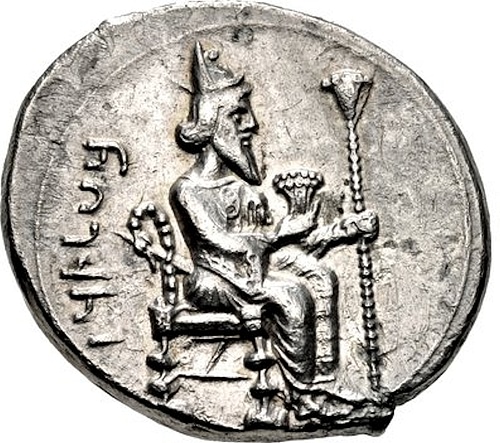
Monarchs from Artaxerxes IV to Artaxerxes V (338-329 BCE)
Artaxerxes IV (r. 338-336 BCE) was the son of Artaxerxes III and his principal wife Atossa. He is known as Arses by the Greeks which was probably his actual name before he took the throne name of Artaxerxes IV. Under his reign, Philip II of Macedon began his overtures to the conquest of Persia in 336 BCE. He was poisoned, along with his family, by Bagoas who then placed his (Bagoas') cousin Artashata on the throne who took the throne name Darius III.
Darius III (r. 336-330 BCE) was born Artashata, grandson of Artaxerxes II by his daughter Sisygambis, and was given the satrapy of Armenia, seemingly, just because he was of the royal family. He had no training in ruling an empire and, apparently, no desire to do so but was installed on the throne by Bagoas who thought to rule through him. When it became clear to Bagoas that Darius III could not be controlled, he tried to poison the king but was instead forced to drink the poison himself. Darius III's rule was contentious from the start because the unexpected death of Artaxerxes IV had encouraged various regions to revolt and Darius III had no idea how to handle the situation. These problems paled, however, against the invasion of his empire by the Macedonian army under Alexander the Great in 334 BCE who arrived to complete what his father had started and avenge the 490 and 480 BCE invasions of Greece. Darius III was defeated in every engagement with Alexander, fleeing the field at the Battle of Issus in 333 BCE and leaving behind his family who were then taken care of by Alexander. He was completely defeated at the Battle of Gaugamela in 331 BCE, where he again fled the field, and was later assassinated by his relative, and satrap of Bactria, Bessus.
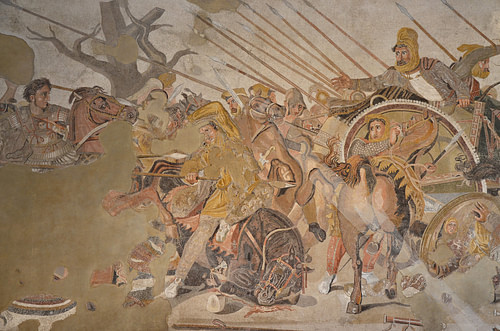
Artaxerxes V (r. 330-329 BCE) was the short-lived throne name of Bessus, satrap of Bactria, who assassinated Darius III and proclaimed himself king. Alexander the Great found the dead or dying Darius III (the original accounts vary on this) in a cart where Bessus had left him and gave him a proper burial with all honors. Afterwards, Alexander had Bessus executed and took for himself the honor of the title Shahanshah, the king of kings of the Achaemenid Empire.
Conclusion
Although the Achaemenid Empire was no longer what it had been under Darius I, it was still intact when Alexander conquered it. He attempted a synthesis of Greek and Persian cultures by marrying his soldiers to Persian women, elevating Persian officers to high rank in his army, and comporting himself as a Persian king. His efforts were not appreciated by the Greek/Macedonian army and, after his death in 323 BCE, his vision was abandoned. Since he had named no clear successor at the time of his death, his generals went to war with each other to claim supremacy.
These wars (known as the Wars of Diadochi, 322-275 BCE), resulted, in part, in the rise of the Seleucid Empire (312-63 BCE) under Alexander's general Seleucus I Nicator (r. 305-281 BCE). The Seleucid Empire occupied approximately the same regions as the Achaemenid and, though it rose to a position of strength, gradually lost territory, first to the Parthians and then later to Rome. The Seleucids were succeeded by the Parthian Empire (247 BCE- 224 CE) which fell to the Sassanian Empire (224-651 CE). The Sassanians revived the best aspects of the Achaemenid Empire and would become the greatest expression of Persian culture in the ancient world.
The Sassanian Empire preserved the culture of the Achaemenids and, even after its fall to the invading Muslim Arabs, this culture would endure and spread throughout the ancient world. Many aspects of life in the modern day, from the seemingly mundane of birthday parties, desserts, and teatime to the more sublime of monotheism, mathematics, and aspects of art and architecture, were developed by the Sassanians drawing on the model of the Achaemenid Empire.
